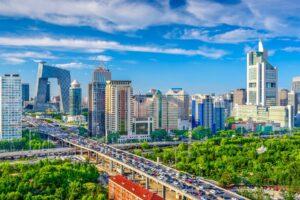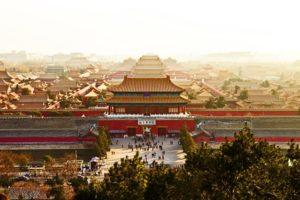Fodor's Expert Review Temple of Heaven
A prime example of Chinese religious architecture, this is where emperors once performed important rites. It was a site for imperial sacrifices, meant to please the gods so they would generate bumper harvests. Set in a huge, serene, mushroom-shaped park southeast of the Forbidden City, the Temple of Heaven is surrounded by splendid examples of Ming Dynasty architecture, including curved cobalt blue roofs layered with yellow and green tiles. Construction began in the early 15th century under Yongle, whom many call the "architect of Beijing." Shaped like a semicircle on the northern rim to represent heaven and square on the south for the earth, the grounds were once believed to be the meeting point of the two. The area is double the size of the Forbidden City and is still laid out to divine rule: buildings and paths are positioned to represent the right directions for heaven and earth. This means, for example, that the northern part is higher than the south.
The temple's hallmark... READ MORE
A prime example of Chinese religious architecture, this is where emperors once performed important rites. It was a site for imperial sacrifices, meant to please the gods so they would generate bumper harvests. Set in a huge, serene, mushroom-shaped park southeast of the Forbidden City, the Temple of Heaven is surrounded by splendid examples of Ming Dynasty architecture, including curved cobalt blue roofs layered with yellow and green tiles. Construction began in the early 15th century under Yongle, whom many call the "architect of Beijing." Shaped like a semicircle on the northern rim to represent heaven and square on the south for the earth, the grounds were once believed to be the meeting point of the two. The area is double the size of the Forbidden City and is still laid out to divine rule: buildings and paths are positioned to represent the right directions for heaven and earth. This means, for example, that the northern part is higher than the south.
The temple's hallmark structure is a magnificent blue-roofed wooden tower built in 1420. It burned to the ground in 1889 and was immediately rebuilt using Ming architectural methods (and timber imported from Oregon). The building's design is based on the calendar: 4 center pillars represent the seasons, the next 12 pillars represent months, and 12 outer pillars signify the parts of a day. Together these 28 poles, which also correspond to the 28 constellations of heaven, support the structure without nails. A carved dragon swirling down from the ceiling represents the emperor.
Across the Danbi Bridge, you'll find the Hall of Prayer for Good Harvests. The middle section was once reserved for the Emperor of Heaven, who was the only one allowed to set foot on the eastern side, while aristocrats and high-ranking officials walked on the western strip.
If you're coming by taxi, enter the park through the southern entrance (Tiantan Nanmen). This way you approach the beautiful Hall of Prayer for Good Harvests via the Danbi Bridge—the same route the emperor favored.
Directly east of this hall is a long, twisting platform, which once enclosed the animal-killing pavilion. The Long Corridor was traditionally hung with lanterns on the eve of sacrifices. Today it plays host to scores of Beijingers singing opera, playing cards and chess, and fan dancing.
Be sure to whisper into the echo wall encircling the Imperial Vault of Heaven. This structure allows anyone to eavesdrop. It takes a minute to get the hang of it, but with a friend on one side and you on the other it's possible to hold a conversation by speaking into the wall. Tilt your head in the direction you want your voice to travel for best results. Just inside the south gate is the Round Altar, a three-tiered, white-marble structure where the emperor worshipped the winter solstice; it's based around the divine number nine. Nine was regarded as a symbol of the power of the emperor, as it's the biggest single-digit odd number, and odd numbers are considered masculine and therefore more powerful.
The Hall of Abstinence, on the western edge of the grounds, is where the emperor would retreat three days before the ritual sacrifice. To understand the significance of the harvest sacrifice at the Temple of Heaven, it's important to keep in mind that the legitimacy of a Chinese emperor's rule depended on what is known as the tian ming, or the mandate of heaven, essentially the emperor's relationship with the gods.
A succession of bad harvests, for example, could be interpreted as the emperor losing the favor of heaven and could be used to justify a change in emperor or even in dynasty. When the emperor came to the Temple of Heaven to pray for good harvests and to pay homage to his ancestors, there may have been a good measure of self-interest to his fervor.
The sacrifices consisted mainly of animals and fruit placed on altars surrounded by candles. Many Chinese still offer sacrifices of fruit and incense on special occasions, such as births, deaths, and weddings.
We recommend buying an all-inclusive ticket. If you only buy a ticket into the park, you'll need to pay an additional Y20 to get into each building.
Beijing's subway Line 5 (purple line) makes getting to the Temple of Heaven particularly simple. Get off at the Tiantandongmen (Temple of Heaven East Gate) stop. This line also runs direct to the Lama Temple (Yonghegong), so combining the two sites in a day makes a lot of sense.
Automatic audio guides (Y40) are available at stalls inside all four entrances.
READ LESS







